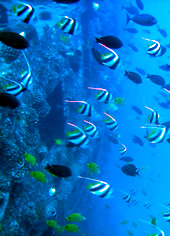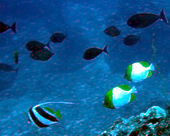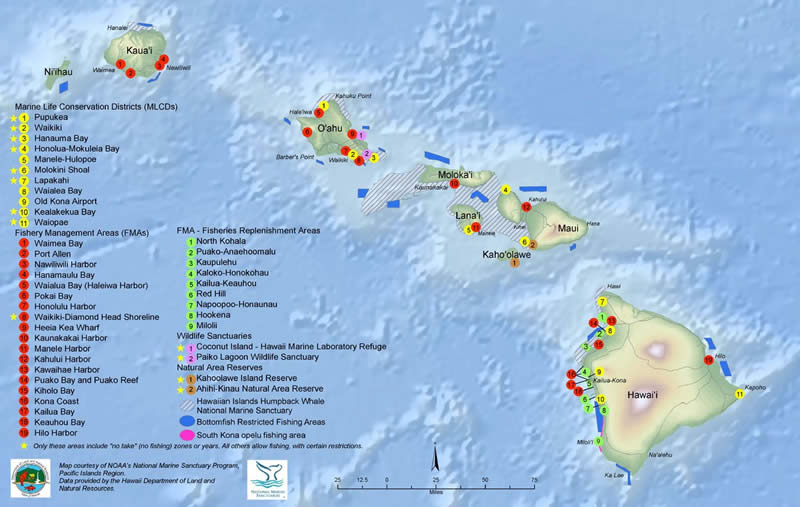Legal Precedence
What is the legal precedence to the use of Hawaii’s near shore fisheries? United Nations Conference on Environment and Development laws state the Oceans and their resources are the common heritage of man.
State of Hawaii regulates near shore waters within 3 miles. Outside that falls under Federal regulations. Following International and Federal law, The State of Hawaii has the responsibility to care for and share with all our Oceans resources.
No one group in Hawaii can make claim or shut out another group. Ecology groups cannot claim and close all to others for their preservation views. Fishermen cannot claim areas for their use only. International law states no one group can lay claim to the ocean or its resources.
U.S. laws are based on these UN resolutions. State law should follow this precedence. We must all share in caring for and utilizing our States Ocean resources. DNLR (Department of Land and Natural Resources) our States Ocean and forest regulatory agency says about aquarium fish collecting issues that “it is not a resource issue”.
Hawaii’s aquarium fish industry has tried to manage resources by leaving tourist areas to tour groups. We respect closed areas for fish and ecosystem preservation. We have no conflict with eating or subsistence fishermen. We use fish as ambassadors around the world to promote tourism for the State.
Hawaii’s aquarium fish have worldwide recognition. For a considerable period of time we have maintained a sustainable industry with nearly stationary catches and the nearly same amount of collectors. Our fish are cared for using the latest technology and are shipped by fastest air freight to individuals around the world.
Health and happiness of the fish is the main goal for the tropical fish collector. Fish as pets is based on people who love their fish and go to great effort to keep them happy. Hawaii has the strictest laws of any state regulating the aquarium trade. The majority of the fish in the ocean are able to avoid capture and remain in the wild. Geographical distances, weather and isolation ensures ninety percent of Hawaii’s oceans remain untouched by aquarium fish collectors.
Most of Hawaii’s Islands do not have any collection for aquarium fish. The Hawaii tropical fish collector dives for the most part in fishing grounds which have been collected from for many years. Rotation of fishing spots and never over collecting has ensured a sustainable industry which will be able to continue forever at current rates! This voluntary subscription to self-regulation has proven prudent over time and negates the need for further restrictive regulations.
Reef fish mostly broadcast breed by spreading larvae out to sea. Reef fish produce one million to five million fry per spawning. For example Yellow Tangs spawn one million fry per pair and around 60 percent of the larvae return to the reef from where they originated. Yellow Tangs can spawn several times a year. Yellow Tang larvae mature for 30 days then return to the reef where they grow to breeding size. Breeding size, three and one half inches, is reached in less than a year.
Fish are the most efficient breeders in the world. Fishing is the most sustainable industry in the world. Fish are the most renewable resource on the planet. The total number of fish and inverts taken from the whole State of Hawaii in one year is less than the amount one breeding pair of yellow tangs can produce at one breeding. Overall fish populations are impacted very little by aquarium fish collection.
Hawaii’s tropical fish industry is a very important part of a 7 billion dollar a year U.S. pet industry. A marine fish from Hawaii is the foundation for numerous other industries.
If an Economic Impact Statement (EIS) was done for our industry we would contend it find our States Tropical Fish Industry has incredible impacts not only for the State of Hawaii’s Economy but also worldwide!
The ability of user groups to profit from ocean resources without impacting the highly renewable resource should always be the goal.
Industry
Aquarium Fish Industry
The aquarium fish industry has been a sustainable industry for over 50 years and fish counts and catch reports (catch report data attached) confirm proof of its sustainability. The $3 million study of FRA (Fish Replenishment Area) and non-FRA off Kona provide more proof of Hawaii’s sustainable aquarium fish industry.
See the researchers information who was in charge of these studies under fish populations. Even with 30% closure in Kailua Kona we have maintained sustainability. There are only a few aquarium fish divers on Maui. Maui experiences little impact from aquarium fish collecting. With Maui having the least impact with less than #5 of all fish take done by them shows how little of an impact Aquarium fish collecting has.
Oahu and he Big Island are the main areas with the most fish collected. On those Islands aquarium fish take represents less than 20% of the total fish taken from the ocean.
Aquarium fish hobbyists spend a lot of money to keep the fish they buy healthy and happy. Enriched foods, controlled environments, medications and lack of predators greatly increase the lifespan of fish. Breeders are successfully breeding many species caught in Hawaii and may become future main suppliers for Hawaiian indigenous fish.
Local fish have been kept alive for 20 years or more in aquariums while this same fish normally could survive in the wild for only a few years. Eels, sharks, larger fish constantly prey on the reef fish day and night. Sharks consume 20% of their body weight per day. If a large 800 pound tiger shark consumes 160 pounds of fish per day then one shark eats two time more fish than all aquarium fish collectors take.
The average reef fish weighs 1 ounce making one sharks daily diet equal to 2560 small reef fish a day. In one year 486,000 reef fish were taken. This helps to put it into perspective.
Tropical fish divers get paid only when they deliver live healthy fish so prudent collection is the only way to make money in the business. Care of each fish to make loving pets for hobbyist is the goal of Hawaii’s Aquarium trade.
We love Hawaii’s Underwater beauty and wish to share with all the oceans we love with all.
Laws
Strict Laws
Some ant-aquarium fish tourist shop owner activist say fish collectors have no regulations and can take as many fish as they want.
That is simply not a true statement.
Aquarium fish taking is highly regulated and the collectors must answer to Fish and Wildlife, DNLR enforcement, Department of Agriculture and the USDA. Tropical fish require veterinarian inspections when shipped to certain areas.
Health and quality of fish are ultimately everything. Size limits, preserves, marine protected areas (MPA) and nearly 100 laws regulate tropical fish collecting-not to mention in addition to these restrictions, environmental issues such as weather, surf and accessibility restrict diving greatly.
“Even if the number of aquarium fish collectors greatly increase it would still be a sustainable fishery”, said Dr. Rossitor of Waikiki Aquarium, testifying in favor of self-imposed Oahu rules package hearing.
Divers
Few Divers, Limited Catches
There are 94 divers in all of Hawaii who collect tropical fish. There are 34 divers in Kona, 51 on Oahu and 9 in Maui. Of the 94 many are shippers and do not dive much. There are far more ex-tropical fish divers with permits than current divers.
Most of these divers have side jobs or cannot dive full time due to weather restrictions. Collectors rotate their spots and have been in business for as long as 40 years. Tropical fish collectors make money from long-term collecting from the same rotated areas.
Due to decompression limits a diver can cover at most 50 square feet per dive with a limit of two to four dives a day. Tropical fish divers average 60 feet deep dives. Air supply limits them to 40 minutes a dive. Deep dives are greatly limited as decompression times and limited number of dives restricts deep dives.
Very few fish are taken from deep depths. Live fish, unlike dead eating fish, require lots of clean water during transport greatly limiting catch quantity. Catch is greatly limited on each boat by the amount of fish we can be maintained in a very healthy state.
Fish IQ
Smart Fish
Fish are very smart and avoid the net – having just one run at the net before they become net wise and avoid it. Divers go out just a few days a week. Fish run from the divers and hide in spaces like coral, artificial reefs, rocks, etc. preventing the capture of most fish in the area.
Big breeders take up too much space in the catch bucket so abundant smaller fish are caught. This naturally ensures breeders are left for repopulation. Most small fish do not reach adulthood due to predators and food supply.
In the long run, overall populations are not impacted. It would be impossible to catch all the fish from one area.
Divers have a financial interest in leaving breeders and some fish of all sizes to increase the populations. Rotating spots insures future money from diving. All divers use rotation of fishing areas.
Low fish population areas are not collected from because it is not profitable. Low fish population areas are not collected from ensuring repopulation. Decrease of high population areas allows more food supply for the other fish ensuring healthy populations especially for rarer fish.


